High-Vacuum CF Flange Viewport with Ø10 mm CVD Diamond Window

- CF Flange Viewports for High-Vacuum Systems
- Includes a Ø10 mm Polycrystalline CVD Diamond Window
- Ø6.0 mm Clear Aperture
VC206
Ø10.0 mm Flat Window
Viewport, CVD Diamond Window
Front
Back
VGA10
Annealed Copper Gaskets, 10 Pack
VMH6
Flange Mounting Hardware Pack (6 Bolts, 6 Nuts, & 12 Washers)

Please Wait
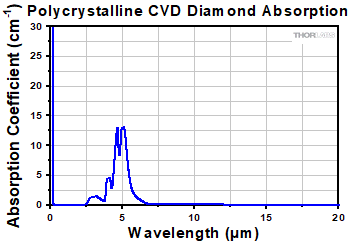
Click to Enlarge
Absorption Spectrum of the CVD Diamond Window
| Vacuum Specifications | |
|---|---|
| Vacuum Level | 1 x 10-8 Torr (Max) |
| Max Temperature | 150 °C |
| Thermal Gradient | 20 °C/min (Max) |
Features
- Vacuum Level: 1 x 10-8 Torr (Max)
- Bake Temperature: 150 °C (Max)
- Includes a Ø10.0 mm x 0.5 mm Thick CVD Diamond Window
- Ø0.24" (Ø6.0 mm) Clear Aperture
- Features SM05 and SM1 Internal Threading for Ø1/2" and Ø1" Lens Tubes
- Flange Mounting Hardware Pack and Copper Gaskets Sold Below
Thorlabs' High-Vacuum-Compatible Ø2.75" (DN40) CF Flange Viewport with a Ø10 mm Polycrystalline CVD Diamond Window offers optical access into high-vacuum systems down to 10-8 Torr. In addition to four 4-40 mounting holes for compatibility with our 30 mm cage systems, the flange features coaxial internal SM05 and SM1 threading for mounting Ø1/2" and Ø1" Lens Tubes.
Diamond boasts a broad transmission spectrum (220 nm to >50 µm), as well as a high level of thermal conductivity (>2200 Wm-1K-1 at 300 K, and >1600 Wm-1K-1 at 425 K). The absorption spectrum of the included window is shown to the right. The low absorption of these diamond windows allows high power laser light to be transmitted without causing damage to the window itself. Diamond may also be suited for medical applications due to its biocompatibility, and its broad transmission spectrum increases efficiency when used within spectroscopy setups.
Designed for use at high-vacuum (HV) pressures, Thorlabs' CF viewports utilize Viton O-Ring seals to create an air-tight metal/glass seal, allowing for pressures down to 10-8 Torr. These flanges are non-rotating and should only be used with the included CVD diamond window; if a replacement is needed, this window (Item # WGM1005) can be purchased separately.
Copper gasket and mounting hardware sets for Ø2.75" CF flanges are also available below. The viewport has six 1/4" (M6) through holes for bolting onto any standard Ø2.75" CF flange. Thorlabs also offers HV CF Flange Viewports for Ø1" flat windows, Ø1.5" flat windows, and Ø1.5" wedged windows.
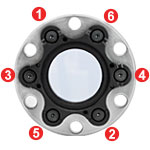
Click to Enlarge
Fig. 5: Order of faceplate screw tightening.
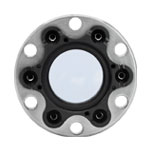
Click to Enlarge
Fig. 4: Viewport with faceplate aligned over screw holes.
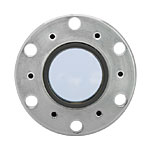
Click to Enlarge
Fig. 3: Viewport with top O-ring placed on window.
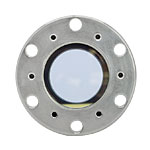
Click to Enlarge
Fig. 2: Viewport with window placed on bottom O-ring.
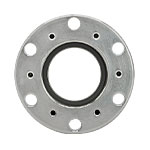
Click to Enlarge
Fig. 1: Viewport with front face removed and O-ring inserted.
Our high-vacuum viewports allow the user to install or swap out windows as they desire, or as experimental conditions demand. Installation of the windows is relatively quick and simple. The following steps describe how to install and change windows in our high-vacuum CF flanges.
Step 1: Inspect the O-ring and seat for pits, scratches, or contamination. Remove any loose debris from the seat using compressed air and then install the O-ring in the seat (see Fig. 1). If necessary, clean the window by following our optics cleaning tutorial.
Step 2: Place the window on top of the O-ring (see Fig. 2) and then place and center the second O-ring on top of the window (see Fig. 3).
Step 3: Set the faceplate on top of the window, lining up the O-ring with the faceplate groove and the six holes in the faceplate with the threaded holes in the flange (see Fig. 4). Do not slide the part across the window surface.
Step 4: Place the six screws in the faceplate holes and use a 5/64" (2.0 mm) hex key to thread them so that they are just making contact with the faceplate.
Step 5: In the order illustrated in Fig. 5, turn each screw a quarter turn, repeating the pattern until the faceplate is tight against the flange.
Insights into CF Vacuum Flanges
Scroll down to read about:
- Working with CF Vacuum Flanges
Click here for more insights into lab practices and equipment.
Working with CF Vacuum Flanges
A vacuum coupling that supports operation at ultra-high-vacuum levels
Damage to the knife edge, an aggressive approach to tightening the bolts, and reusing gaskets can all result in leaky CF vacuum couplings. The techniques demonstrated in this video reduce the risk presented by these factors, which are all related to the limited malleability of the metal gasket. It is important that the knife edges are in pristine condition, since the gasket is not soft enough to fill narrow or abrupt features, such as a nick in a knife edge. An approach of gradually and iteratively tightening the bolts is effective in maintaining a uniform thickness of the gasket around its circumference, while tightening each bolt all at once can result in thickness variations in the gasket that are difficult or impossible to flatten. This is a consequence of the metal gasket’s limited ability to flow and can result in gaps between the gasket and knife edges. Using a new gasket is always recommended. Even a gasket that was only partially compressed during a previous use may not be malleable enough, when reused, to conform to the contours of the knife edges. This is because compression has the effect of strain (work) hardening the metal.
While a leaky vacuum connection can result in time lost to leak checking and re-opening the vacuum system to locate and fix the problem, productive work can also be delayed as a result of broken or malfunctioning components in or attached to the chamber. Due to this, an overview of special considerations for handling and using fiber feedthroughs is also included in this video.
If you would like more information about tips, tricks, and other methods we often use in the lab, we recommend our other Video Insights. In addition, our webinars provide practical and theoretical introductions to our different products.
ConFlat® is a registered trademark of Agilent Technologies, Inc.
| Products Featured During Demonstration | |||
| Optical Fiber Feedthrough | 1/4-Hard Copper Gaskets | Fiber Inspection Scope | Nitrile Gloves |
| UHV Fiber Patch Cable | Solvent Dispenser | Fiber Connector Cleaner | Wipes |
Date of Last Edit: Sept. 21, 2022
| Posted Comments: | |
| No Comments Posted |


Click for Details
Mechanical Drawing of VC206 Viewport
- Ø2.75" CF Viewport with Ø10.0 mm Polycrystalline CVD Diamond Window
- Viton O-Ring Metal to Glass Seal
- Clear Aperture: Ø0.24" (Ø6.0 mm)
Thorlabs' Ø2.75" CF flange viewports allow for optical access into high-vacuum (HV) systems down to 10-8 Torr. The VC206 Viewport is a fixed (non-rotating) flange with a Ø10 mm CVD diamond window that provides a Ø0.24" (Ø6.0 mm) clear aperture (CA). This viewport has six 1/4" (M6) through holes for bolting onto any standard Ø2.75" CF flange. Please note that mounting hardware is not included.
This viewport comes with a polycrystalline CVD diamond window installed and should only be replaced if needed with Item # WGM1005. Before replacing, please review the procedure outlined in the Window Installation tab above.


Click to Enlarge
VGC10 Copper Gasket Installed on a VC206 Viewport
- VMH6 Stainless Steel (18-8) Mounting Hardware Set Includes:
- Six Bolts (Silver-Plated, 1/4"-28 x 1.50", 12-Point Heads)
- Six Nuts and Twelve Washers
- Single-Use Copper Gaskets for Forming a Seal Between Ø2.75" CF Flanges
- 101 Copper Alloy (99.99% Pure), OFHC (Oxygen-Free High Conductivity)
- VGC10: 1/4-Hard Copper Gaskets
- VGA10: Annealed Copper Gaskets
Thorlabs offers mounting hardware and single-use copper gaskets for mating Ø2.75" CF flanges. These flanges utilize a knife-edge mechanism to create an airtight seal between mating pieces. To create the seal, a copper gasket is most often employed. As the bolts of the mating pair are tightened, the knife edge bites into the copper gasket, deforming it. The extruded metal fills all the machining marks and surface defects, which yields a leak-tight seal.
1/4-hard and annealed copper gaskets are sold in sets of 10. We recommend the 1/4-hard copper gaskets for most applications; for more delicate devices, such as viewports, we recommend using the softer annealed copper gaskets to lower the chance of deformation in the optic due to stress in the flange. The set of stainless steel mounting hardware includes six silver-plated bolts, six nuts, and twelve washers. The silver plating on the bolts acts as a lubricant to prevent galling between the stainless steel surfaces of the bolt and the nut.
Instructions
First ensure the knife-edge mating surfaces of the CF flanges are free from debris or scratches. Then choose the desired bolt hole orientation and insert the gasket, aligning leak-test grooves on the flanges if present. Slide a washer onto the bolt, insert the bolt through the flanges, and add another washer before screwing on the nut. Hand tighten each bolt, then use two wrenches to hold the bolt head and turn the nut. Tighten the nuts gradually in 1/8 to 1/4 turn increments in an alternating crisscross star pattern until the desired tightness is reached. Following these steps will result in a reliable seal with even gasket compression and deformation.
 Products Home
Products Home












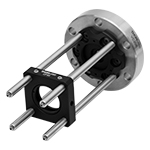




 Zoom
Zoom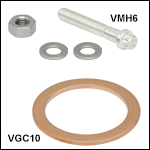
 High-Vacuum Viewport, Ø10 mm Diamond Window
High-Vacuum Viewport, Ø10 mm Diamond Window